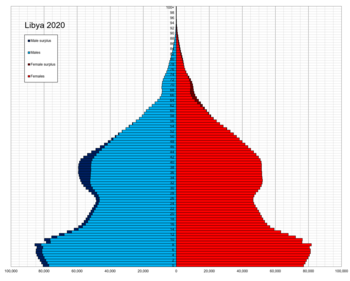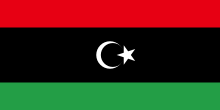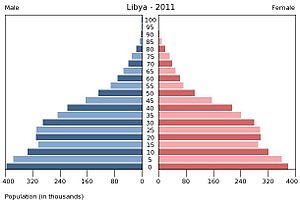
A | B | C | D | E | F | G | H | CH | I | J | K | L | M | N | O | P | Q | R | S | T | U | V | W | X | Y | Z | 0 | 1 | 2 | 3 | 4 | 5 | 6 | 7 | 8 | 9
| Demographics of Libya | |
|---|---|
 Population pyramid of Libya in 2020 | |
| Population | 7,137,931 (2022 est.) |
| Growth rate | 1.65% (2022 est.) |
| Birth rate | 21.56 births/1,000 population |
| Death rate | 3.45 deaths/1,000 population |
| Life expectancy | 73.29 years |
| • male | 70.27 years |
| • female | 76.11 years |
| Fertility rate | 3.09 children |
| Infant mortality rate | 5.22 deaths/1,000 live births |
| Net migration rate | 1.61 migrant(s)/1,000 population |
| Sex ratio | |
| Total | 1.04 male(s)/female (2022 est.) |
| At birth | 1.05 male(s)/female |
| Nationality | |
| Nationality | Libyans |
| Major ethnic | Arabs (92%)[1] |
| Minor ethnic | Berbers (5%) Others (3%)[1] |
| Language | |
| Official | Arabic |
ليبيون (Libiūn) | |
|---|---|
 | |
| Total population | |
| c. 8 million | |
| Regions with significant populations | |
7,137,931 (2022 est.)[2] | |
| 2,671,188 (2016)[3] | |
| 250,900 (2018)[citation needed] | |
| 200,000 (2016)[4] | |
| 55,000 (2015)[citation needed] | |
| 54,500 (2022)[citation needed] | |
| 50,600 (2019)[5] | |
| 25,000[citation needed] | |
| 21,677 (2022)[6] | |
| 15,000 (2019)[citation needed] | |
| 14,000[7] | |
| 13,827[7] | |
| 13,545[8] | |
| 11,979 (2000)[9] | |
| 11,000 (2021)[citation needed] | |
| 5,622 (2017) | |
| 1,820 (2015)[citation needed] | |
| 1,000 (2019)[citation needed] | |
| Languages | |
| Majority: Arabic (Libyan Arabic) Minority: Berber (Awjila, Nafusi, Tamasheq), Teda Foreign: Italian, Turkish, English, Greek | |
| Religion | |
| Majority: Sunni Islam Minority: Ibadi Islam | |
Demographics of Libya is the demography of Libya, specifically covering population density, ethnicity, education level, health of the populace, economic status, and religious affiliations, as well as other aspects of the Libyan population. The Libyan population resides in the country of Libya, a territory located on the Mediterranean coast of North Africa, to the west of and adjacent to Egypt. Libyans live in Tripoli. It is the capital of the country and first in terms of urban population, along with Benghazi, Libya's second largest city.
History

Historically Berber, over the centuries, Libya has been occupied by the Phoenicians, Greeks, Romans, Arabs, and Italians. The Phoenicians had a big impact on Libya. Many of the coastal towns and cities of Libya were founded by the Phoenicians as trade outposts within the southern Mediterranean coast in order to facilitate the Phoenician business activities in the area. Starting in the 8th century BCE, Libya was under the rule of the Phoenician Carthage. After the Romans defeated Carthage in the Third Punic War, Libya became a Roman province under the name of Tripolitania until the 7th century CE when Libya was conquered by the Arab Muslims as part of the Arab conquest of North Africa, and Arab migrations to the region began since then. In the 11th century, major migrations of Banu Hilal and Banu Sulaym from the Arabian Peninsula to Libya began, with other nomadic tribes from Eastern Arabia.[10] Centuries after that, the Ottoman Empire conquered Libya in 1551. It remained in control of its territory until 1911 when the country was conquered by Italy. In the 18th century Libya was used as the base for various pirates. The story of the Awlad Sulayman, an Arab group from present-day Libya dominated northern Lake Chad in the 19th century. Since the Middle Ages, the populations of this region have shared close political, economic, and social ties maintained by the mobility specific to the nomadic way of life. These relationships, fluid due to the difficulties of surviving in this difficult environment, have always been structured in turn, through conflict and cooperation, both of which produced rapidly changing alliances. In the middle of the 18th century, the Awlad Sulayman carved out a vast area of influence for themselves in Sirte and Fezzan by force of arms and by their alliances with neighboring peoples and the Libian administration. Defeated by the Ottoman administration in Tripoli at the end of the 1830s, the survivors of the Awlad Sulayman took refuge in the Lake Chad basin where they reconstituted the conditions for their success in Libya; they controlled trans-Saharan trade and maintained their links with Libian society. Despite the limits imposed on their action by the French colonization of Chad and the Italian colonization of Libia; the Awlad Sulayman retained regional influence during colonial times and appear to maintain it today. In the Second World War Libya was one of the main battlegrounds of North Africa. During the war, the territory was under an Anglo-French military government until it was overrun by the Axis Powers, who, in turn, were defeated by the Allies in 1943.[11]
In 1951, the country was granted independence by the United Nations, being governed by King Idris. In 1969, a military coup led by Muammar Gaddafi resulted in the overthrow of King Idris I. Gaddafi then established an anti-Western leadership. In 1970, Gaddafi ordered all British and American military bases closed.
The Libyan population has increased rapidly after 1969. They were only 2 million in 1968, and 5 million in 2006. [citation needed]. Many migrant workers came to Libya since 1969. Among the workers were construction workers and laborers from Tunisia, teachers and laborers from Egypt, teachers from Palestine, and doctors and nurses from Yugoslavia and Bulgaria. 1,000,000 workers, mainly from other neighboring African countries like Sudan, Niger, Chad and Mali, migrated to Libya in the 1990s, after changes were made to Libya's Pan-African policies.[12]
Gaddafi used money from the sale of oil to improve the living conditions of the population and to assist Palestinian guerrillas in their fight against the Israelis. In 1979, Libya fought in Uganda to assist the government of Idi Amin in the Ugandan Civil War, and in 1981, fought in the Libyan-Chadian War. Libya had occupied the Aozou Strip; however, in 1990 the International Court of Justice submitted the case and allowed the full recuperation of territory to Chad.
In September 2008, Italy and Libya signed a memorandum by which Italy would pay $5 billion over the next 20 years to compensate Libya for its dominion over Libya for its reign of 30 years.[13]
Since 2011, the country is swept by Libyan Civil War, which broke out between the Anti-Gaddafi rebels and the Pro-Gaddafi government in 2011, culminating in the death and overthrow of Gaddafi. Nevertheless, even today Libya still continues to generate problems within the area and beyond, greatly affecting its population and the migrant route to Europe.
Under Gaddhafi the country had oil income and a level of stability, allowing birthrates to fall to 2.56 by 2010. However, with instability, the government in Libya announced population of 7.7 million as of Oct 2022, indicating a substantial population boom and/or migration. Since migration is less likely, birthrates probably soared as women no longer afforded security of the old regime, about 10-15% higher than expected.
Population


Libya has a small population residing in a large land area. Population density is about 50 persons per km2 (130/sq. mi.) in the two northern regions of Tripolitania and Cyrenaica, but falls to less than one person per km2 (2.7/sq. mi.) elsewhere. Ninety percent of the people live in less than 10% of the area, primarily along the coast. About 90%[14] of the population is urban, mostly concentrated in the four largest cities, Tripoli, Benghazi, Misrata and Bayda. As of 2019, twenty-eight percent of the population is estimated to be under the age of 15, but this proportion has decreased considerably during the past decades.[15] The majority of the population of Libya is composed of Arabs.[10][16][17]
| Year | Total population ( × 1000) |
Population in age bracket | ||
|---|---|---|---|---|
| aged 0–14 | aged 15–64 | aged 65+ | ||
| 1950 | 1,029 | 41.9% |
53.4% |
4.7% |
| 1955 | 1,126 | 43.0% |
52.7% |
4.3% |
| 1960 | 1,349 | 43.3% |
52.7% |
4.0% |
| 1965 | 1,623 | 43.4% |
53.0% |
3.6% |
| 1970 | 1,994 | 45.2% |
52.1% |
2.7% |
| 1975 | 2,466 | 46.5% |
51.3% |
2.2% |
| 1980 | 3,063 | 47.0% |
50.7% |
2.2% |
| 1985 | 3,850 | 47.3% |
50.5% |
2.3% |
| 1990 | 4,334 | 43.5% |
53.9% |
2.6% |
| 1995 | 4,775 | 38.3% |
58.8% |
2.9% |
| 2000 | 5,231 | 32.4% |
64.2% |
3.4% |
| 2005 | 5,770 | 30.6% |
65.6% |
3.8% |
| 2010 | 6,355 | 30.4% |
65.3% |
4.3% |
Age distribution
Population Estimates by Sex and Age Group (1.VII.2015) (Data refer to Libyan nationals only.):[18]
| Age Group | Male | Female | Total | % |
|---|---|---|---|---|
| Total | 3 129 026 | 3 033 221 | 6 162 247 | 100 |
| 0–4 | 316 497 | 299 059 | 615 556 | 9.99 |
| 5–9 | 297 303 | 280 602 | 577 905 | 9.38 |
| 10–14 | 284 318 | 270 831 | 555 149 | 9.01 |
| 15–19 | 268 106 | 257 009 | 525 115 | 8.52 |
| 20–24 | 278 875 | 267 533 | 546 408 | 8.87 |
| 25–29 | 289 113 | 282 117 | 571 230 | 9.27 |
| 30–34 | 287 480 | 281 354 | 568 834 | 9.23 |
| 35–39 | 279 699 | 271 907 | 551 606 | 8.95 |
| 40–44 | 235 088 | 231 285 | 466 373 | 7.57 |
| 45–49 | 180 029 | 180 796 | 360 825 | 5.86 |
| 50–54 | 126 799 | 126 848 | 253 647 | 4.12 |
| 55–59 | 87 135 | 86 625 | Zdroj:https://en.wikipedia.org?pojem=Libyan_people
